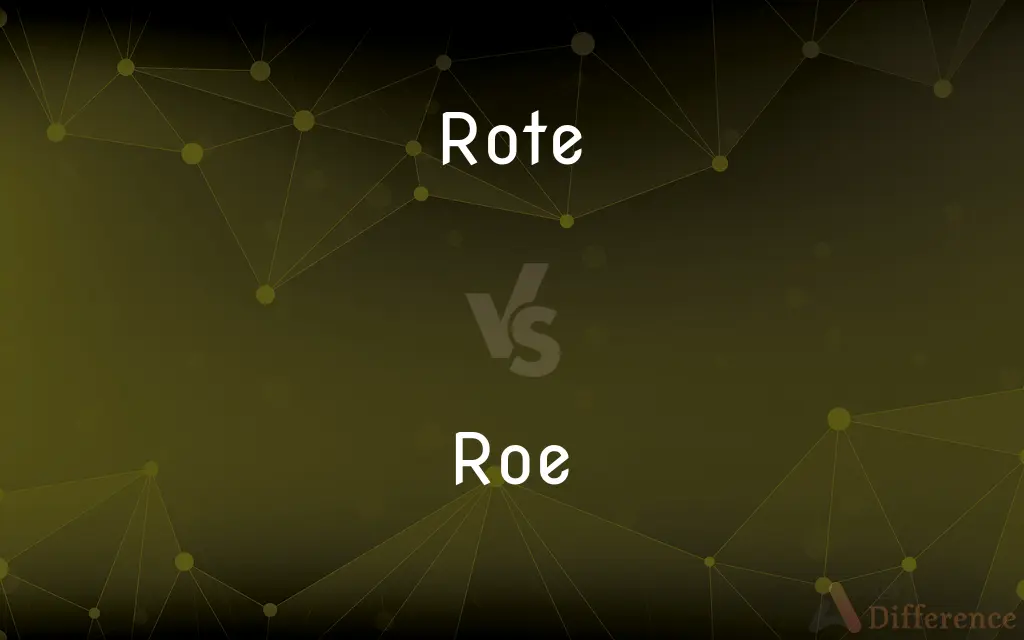Rote vs. Roe — What's the Difference?
By Fiza Rafique & Urooj Arif — Updated on April 26, 2024
Rote learning involves memorization through repetition, focusing on retaining exact information. Roe, on the other hand, refers to the egg masses of fish and certain marine animals, emphasizing biological reproduction.

Difference Between Rote and Roe
Table of Contents
ADVERTISEMENT
Key Differences
Rote learning is a traditional educational technique that emphasizes memorization of information by repetition without necessarily understanding the underlying concepts. This method is often used for learning facts, formulas, or any information that requires exact recall. Whereas roe pertains to the eggs or egg masses of fish and certain marine animals, such as mollusks or crustaceans. Roe is a natural biological product, significant in both ecological terms and as a food source in many cultures.
While rote learning is critiqued for its lack of depth in understanding and critical thinking, it is considered efficient for acquiring basic knowledge that can be quickly recalled. On the other hand, roe plays a crucial role in the reproductive cycles of aquatic life, contributing to the biodiversity and sustainability of marine ecosystems. Rote learning's value lies in educational contexts, particularly when foundational or procedural knowledge must be memorized.
The value of roe extends beyond its biological importance; it is also a delicacy in many culinary traditions worldwide. Rote learning's effectiveness varies among individuals, with some students finding it a helpful way to memorize necessary information, while others may struggle with this method without engaging more deeply with the material. Conversely, the appreciation and consumption of roe depend on cultural, culinary, and personal preferences, highlighting its versatility as a food item.
Rote learning techniques can be applied across various subjects, from language acquisition to mathematics, where memorization of vocabulary, equations, or procedures is essential. Meanwhile, roe, depending on the species, can vary significantly in taste, texture, and nutritional value, making it a diverse ingredient in the culinary world.
The debate over the effectiveness of rote learning in education reflects broader discussions about teaching methodologies and learning outcomes. In contrast, discussions around roe often center on sustainability, ethical harvesting practices, and its role in culinary innovation.
ADVERTISEMENT
Comparison Chart
Definition
Memorization technique through repetition.
Eggs or egg masses of fish and certain marine animals.
Primary Context
Educational methods.
Biology and gastronomy.
Purpose
To facilitate quick recall of information.
Reproduction in aquatic animals; culinary use.
Criticisms
Lack of depth in understanding; mechanical learning.
Sustainability and ethical harvesting concerns.
Variability
In effectiveness among learners.
In taste, texture, and nutritional value by species.
Compare with Definitions
Rote
A method focused on recall rather than understanding.
Rote learning helped him remember historical dates for the exam.
Roe
The eggs or egg masses of fish and certain marine animals.
The chef garnished the dish with salmon roe.
Rote
Learning or memorization by repetition.
She mastered the multiplication table through rote learning.
Roe
Considered a delicacy in many cultures.
Roe is highly prized in Japanese cuisine for its flavor.
Rote
Can be effective for foundational knowledge.
Rote learning is sometimes necessary for mastering the basics of any subject.
Roe
Used in a variety of culinary applications.
Roe can be used as a topping, ingredient, or standalone dish.
Rote
Often used for learning languages, formulas, and facts.
He used rote learning to expand his vocabulary in French.
Roe
Can vary widely in flavor and texture.
Caviar, a type of sturgeon roe, is renowned for its rich taste.
Rote
Criticized for its lack of promoting critical thinking.
Critics argue that rote learning stifles creativity and analytical skills.
Roe
Subject to sustainable harvesting concerns.
Sustainable practices are essential for harvesting roe to protect marine species.
Rote
A memorizing process using routine or repetition, often without full attention or comprehension
Learn by rote.
Roe
Roe () or hard roe is the fully ripe internal egg masses in the ovaries, or the released external egg masses of fish and certain marine animals, such as shrimp, scallop, sea urchins, and squid. As a seafood, roe is used both as a cooked ingredient in many dishes and as a raw ingredient.
Rote
Mechanical routine.
Roe
The eggs or spawn of a fish, contained within or separated from the ovary, especially when prepared as food. Also called hard roe.
Rote
The sound of surf breaking on the shore.
Roe
The milt-containing testes of a fish, especially when prepared as food. Also called soft roe.
Rote
A medieval stringed instrument variably identified with a lyre, lute, or harp.
Roe
The eggs or gonads of certain marine invertebrates, such as a lobster or a sea urchin.
Rote
Mechanical routine; a fixed, habitual, repetitive, or mechanical course of procedure.
The pastoral scenes from those commercials don’t bear too much resemblance to the rote of daily life on a farm.
He could perform by rote any of his roles in Shakespeare.
Roe
The eggs of fish.
Rote
(rare) The roar of the surf; the sound of waves breaking on the shore.
Roe
The sperm of certain fish.
Rote
(musical instrument) A kind of guitar, the notes of which were produced by a small wheel or wheel-like arrangement; an instrument similar to the hurdy-gurdy.
Roe
The ovaries of certain crustaceans.
Rote
Synonym of crowd.
Roe
A mottled appearance of light and shade in wood, especially in mahogany.
Rote
By repetition or practice.
Roe
A roebuck. See Roebuck.
Rote
(obsolete) To go out by rotation or succession; to rotate.
Roe
The ova or spawn of fishes and amphibians, especially when still inclosed in the ovarian membranes. Sometimes applied, loosely, to the sperm and the testes of the male.
Rote
(transitive) To learn or repeat by rote.
Roe
A mottled appearance of light and shade in wood, especially in mahogany.
Rote
A root.
Roe
Fish eggs or egg-filled ovary; having a grainy texture
Rote
A kind of guitar, the notes of which were produced by a small wheel or wheel-like arrangement; an instrument similar to the hurdy-gurdy.
Well could he sing and play on a rote.
Extracting mistuned dirges from their harps, crowds, and rotes.
Roe
Eggs of female fish
Rote
The noise produced by the surf of the sea dashing upon the shore. See Rut.
Roe
The egg mass or spawn of certain crustaceans such as the lobster
Rote
A frequent repetition of forms of speech without attention to the meaning; mere repetition; as, to learn rules by rote.
Till he the first verse could [i. e., knew] all by rote.
Thy love did read by rote, and could not spell.
Roe
The eggs or egg-laden ovary of a fish
Rote
To learn or repeat by rote.
Rote
To go out by rotation or succession; to rotate.
Rote
Memorization by repetition
Common Curiosities
How is roe used in cooking?
Roe is used in various ways, including as a garnish, ingredient, or main dish.
Can rote learning be effective for all subjects?
It is most effective for subjects requiring memorization of facts, languages, and formulas.
What is rote learning?
Rote learning is a memorization technique based on repetition.
What is roe?
Roe refers to the eggs or egg masses of fish and certain marine animals.
What are the criticisms of rote learning?
It is criticized for not fostering understanding or critical thinking skills.
Why is roe considered a delicacy?
Roe is valued for its unique flavors and textures, making it a prized ingredient in many cuisines.
Why is sustainable harvesting of roe important?
It ensures the preservation of marine species and ecosystems for future generations.
What role does roe play in marine ecosystems?
Roe is essential for the reproductive processes of marine animals, contributing to biodiversity.
How does rote learning benefit students?
It facilitates quick recall of factual information and foundational knowledge.
What concerns surround the harvesting of roe?
Ethical and sustainability concerns are significant due to the impact on marine life populations.
Can anyone enjoy roe?
Enjoyment of roe depends on personal taste preferences and cultural exposure.
How does rote learning compare to other learning methods?
Rote learning focuses on memorization, whereas other methods emphasize understanding and critical thinking.
How can rote learning be made more effective?
Combining it with methods that promote understanding can enhance its effectiveness.
How do cultural perceptions of roe vary?
Cultural preferences influence how roe is consumed and appreciated, with it being a delicacy in some cultures.
Is all roe the same?
No, roe varies widely in flavor, texture, and nutritional value depending on the species.
Share Your Discovery

Previous Comparison
Rewrite vs. Revision
Next Comparison
Long vs. LonglyAuthor Spotlight
Written by
Fiza RafiqueFiza Rafique is a skilled content writer at AskDifference.com, where she meticulously refines and enhances written pieces. Drawing from her vast editorial expertise, Fiza ensures clarity, accuracy, and precision in every article. Passionate about language, she continually seeks to elevate the quality of content for readers worldwide.
Co-written by
Urooj ArifUrooj is a skilled content writer at Ask Difference, known for her exceptional ability to simplify complex topics into engaging and informative content. With a passion for research and a flair for clear, concise writing, she consistently delivers articles that resonate with our diverse audience.
















































